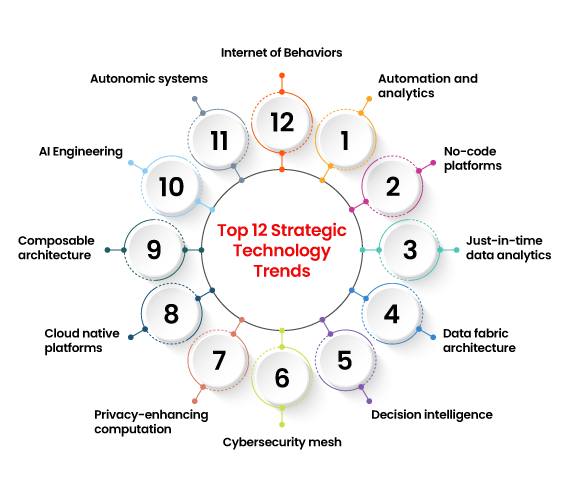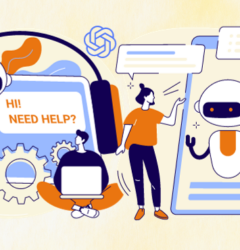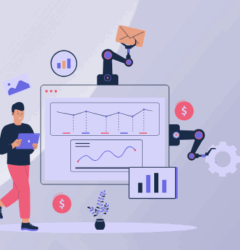
Organizations are constantly buffeted by unexpected events, ranging from COVID-19 to political unrest to climate change. However, the promise of digital business as a means of thriving and outperforming the competition in the face of these disruptions remains unmistakable.
As an IT leader, you bear sole responsibility for the technical side of the digital business. You have the opportunity to leverage force multipliers to accelerate growth and strategically advance your organization.
These advancements will result in the following benefits:
- Trusted digital connections for your people and devices worldwide
- Solutions for rapid scalability of digital creativity in any location
- Cutting-edge capabilities to propel business growth beyond today’s levels
Top 12 Strategic Technology Trends
These technology trends feed off of one another and reinforce one another. These strategic technology trends for 2024 will assist you in meeting your CEO’s scaling, adapting, and growing priorities.

1. Automation and analytics complement each other
The last decade’s innovation has been centered around analytics. By combining descriptive and predictive analytics with automation, we can progress beyond it toward prescriptive guidance.
Artificial intelligence and automation will enable this by dynamically combining relevant data and alerting knowledge workers to take action in advance of an event. You can use analytics to gain a better understanding of what is happening in your system at any given time, and then combine this knowledge with automation to generate intelligent recommendations. In the long run, this technology trend that resides in the number one position will assist you in making better business decisions.
The specific ways in which this can affect various business units:
- Customer service representatives will be notified to contact potentially irate customers prior to their calling in.
- Sales leaders can react immediately to dips in revenue pipeline coverage caused by upstream activities, without having to wait until the end of the quarter,
- Retail managers can combine inventory with data from other items, external market trends, and promotional campaigns from the competition.
2. No-code platforms
In the post-pandemic scenario, “digital acceleration” and “digital disruption” are two phrases that have caught everyone’s attention. The fact of the matter is – these are not merely phrases but have become the living necessities for enterprises across the world. Business models are getting modified or even replaced to find that sweet spot between existing capabilities and future expectations. Organizations need to evolve and find ways to resolve:
- IT skill shortages
- Technical debt
- The communication and collaboration gap between business users and IT teams
Organizations, therefore, will continue to empower their business users (non-programmers) with no-code platforms and tools, so that:
- They can turn into citizen developers
- They can be creative with technology
- They can build bespoke applications – without writing a single line of code
It is an innovative approach to building bespoke, enterprise-grade applications or one-off solutions without writing a single line of code. Instead of using a set of commands to run a program, coders or non-coders can simply drag and drop graphical components in a logical and sequential manner. This new technology trend is only to grow in future and nothing less. With a visual and intuitive interface, no-code platforms enable non-technical teams to configure or reconfigure applications all by themselves, with priority-based involvement from IT organizations. Therefore, no-code development can significantly reduce the time to market apps and increase the problem-solving ability of business users.
Also Explore: 4 Actions to Ensure Your Tech Investments Pay Digital Dividends
3. Just-in-time data analytics
Another issue that the majority of businesses have encountered in the last year? Disruptions in the supply chain. Whether it’s inventory shortages or shipping delays, significant supply chain challenges have left businesses of all sizes and across all industries in a state of panic. Numerous experts believe supply chain analytics must be applied to execute a “just in time” strategy effectively.
When confronted with a full-fledged supply chain crisis, businesses will be forced to address long-standing issues in their data pipelines—bottlenecks and other vulnerabilities—that prevent teams from gaining the visibility into supply chains necessary to survive the decade. Companies will embrace innovative new solutions in order to make ‘just-in-time’ data analytics a reality for their business.
4. Data fabric architecture
Data’s value has never been more apparent. However, data is frequently siloed within applications, preventing it from being used to its full potential. The data fabric connects data across platforms and users, ensuring that data is accessible wherever it is required.
Through inbuilt analytics that read metadata, data fabric can determine how data is being used and recommend additional, different, and better data – thereby reducing data management costs by up to 70%. Organizations must determine priority areas for implementing data fabric solutions by analyzing current data utilization patterns for ongoing business operations using metadata analytics. They can prioritize areas where there is a significant difference in the actual and modeled data.
According to Gartner, by 2024, data fabric deployments will quadruple efficiency in data utilization while cutting human-driven data management tasks in half.
The Finnish city of Turku discovered that data gaps were impeding its innovation. It was able to reuse data, cut time to market in half, and create a monetizable data fabric by integrating fragmented data assets. In no time, business leaders will start embracing this technology trend.
Also read: Understanding Digital Transformation and the way forward
5. Decision Intelligence
Decision intelligence involves modeling every decision as a set of processes that uses intelligence and analytics. It aims at enhancing decision-making ability and learning from decisions.
It gives a practical approach to any decision; as the human element and the technology are perfectly orchestrated it results in effective synergy arising from ever-larger data and common sense.
6. Cybersecurity mesh
Cloud-based and on-premises data centers host digital business assets. Organizations are vulnerable to breaches due to traditional, fragmented security approaches focused on enterprise perimeters.
A cybersecurity mesh architecture enables the creation of scalable and interoperable services through a modular approach to security based on identity. The common integrated structure secures all assets, regardless of their location, enabling a security approach that spans the foundation of information technology services.
According to Gartner, by 2024, organizations adopting a cybersecurity mesh architecture to integrate security tools to work as a cooperative ecosystem will reduce the financial impact of individual security incidents by an average of 90%.
A technology company was having difficulty deriving value from its threat intelligence programme. They used a cybersecurity mesh approach to integrate multiple data feeds from disparate security products in order to quickly identify and respond to incidents.
Watch Related Webinar: 10 Megatrends That Will Define Your Future
7. Privacy-enhancing computation
Privacy-enhancing computation techniques will enable the secure cross-border transfer of data- while it is in function in contrast to while it is in rest or motion. It will secure the processing of data, sharing, and analytics even in untrusted environments.
Privacy-enhancing techniques make use of numerous privacy-protection techniques to extract value while also meeting various compliance measures. This computation is quickly evolving from sharing academic research to real projects. Security of data has always been the top priority for businesses, and there has always been a need to ensure secure cross-border transfer of data, making privacy-enhancing computation another technology trend to embrace.

8. Cloud native platforms
Lift-and-shift cloud migrations are aimed at relocating legacy workloads to the cloud. Due to the fact that these workloads were not intended for the cloud, they require substantial upkeep and do not reap any of the benefits.
Cloud-native platforms leverage cloud computing’s inherent elasticity and scalability to accelerate time to value. They alleviate reliance on infrastructure, freeing up time to concentrate on application functionality. In times of rapid scalability, businesses no longer have to rely on in-house hosting as it may require them costly infrastructure, the technology trend for cloud-native platforms is enabling the business to achieve more with less.
A large Indian bank developed a cloud-native platform for the purpose of launching a new portfolio of digital financial services. The bank was able to cut the time required to set up an account in half and introduce instant digital payments. Implementing new microservices supported the integration of savings, virtual debit cards, and credit card facilities, enabling the system to expand easily to over 3.5 million transactions in two months.
9. Composable architecture
Although modularity is a familiar concept for application architects, the rise of citizen developers (democratization of technology) and fusion teams has thrown up new opportunities, requirements, and challenges.
This democratization of technology delivery requires new processes (application development using no-code platforms). The focus on business-IT fusion teams shifts application modularity from technical APIs to business capabilities (and API products). This is where composable architecture can help organizations distribute responsibilities in a way that organically collaborates business units and IT teams.
Fusion teams face numerous obstacles: they often lack coding skills, are forced to use incompatible technologies, and are frequently tasked with rapid delivery.
Composable applications are constructed using packaged business capabilities (PBCs) or software-defined business objects (SDBOs). PBCs — for example, those representing a patient or a digital twin — generate reusable modules that fusion teams can self-assemble to rapidly develop applications, thereby reducing time to market.
10. AI Engineering
While AI enables organizations to emerge from the pandemic in a strong position, simply adopting AI will not suffice. Organizations must optimize their use of artificial intelligence. AI engineering is the discipline that focuses on operationalizing AI model updates, leveraging integrated data, model, and development pipelines to consistently deliver business value from AI. It combines automated update pipelines with sophisticated artificial intelligence governance.
Organizations are utilizing AI engineering as a strategic differentiator for generating and sustaining value from production AI. They are establishing and refining AI engineering practices that incorporate DataOps, ModelOps, and DevOps best practices.
According to Gartner, by 2025, the 10% of enterprises that establish AI engineering best practices will generate at least three times more value from their AI efforts than the 90% of enterprises that do not.
A Hospital in Toronto understood that AI credibility is critical for physician acceptance. Its fusion teams work to earn physicians’ trust by demonstrating the reliability — and gaps — in AI results.
Also read: 8 Essential Tech Upgrades your Enterprise must consider
11. Autonomic systems
As an organization grows, traditional manual management is incapable of scaling at the same rate. Autonomic systems are self-managing physical or software systems that take in information from their surroundings. However, unlike autonomous or automated systems, they can dynamically alter their algorithms without requiring software updates. This facilitates quick response to change and the management of a dynamic environment at scale.
Organizations can pilot autonomic technologies in situations where early adoption will result in increased agility and performance when managing complex software or physical systems.
A Gartner report suggests that by 2024, 20% of organizations selling autonomic systems or devices will require customers to waive indemnity provisions related to the learned behavior of their products.
A top MNC is responsible for the management of thousands of cellular phone masts in challenging environments. Its autonomous systems dynamically boost 5G networks’ performance through deep learning and digital twins.
12. Internet of Behaviors
As the world continues to digitize, businesses and organizations continue to place a premium on information and data as critical components of success. The Internet of behavior, or IoB for short, is a critical component of customer data. It provides an insightful analysis of consumer behavior. To remain competitive and gain an advantage over emerging threats, organizations can leverage IoB through data collection and analysis to improve customer interactions, better understand consumer preferences, and make more informed purchasing decisions.
In some ways, IoT is related to the Internet of things in that it sheds more light on the purchasing journey of consumers. Additionally, it entails psychological analysis of data collected via IoT and diverse online sources, whether big data, business intelligence, or data protection. In general, this emerging technology aims to assist businesses in meaningfully increasing user engagement and customer experience.
Although this technology trend is still in its infancy, experts estimate that more than half of the world’s population is exposed to at least one IoB programme run by private organizations or governments. This indicates that it could be one of the next technologies to enter the mainstream in the coming years.
Conclusion
For years, digital transformation has been a buzzword in IT circles, and it is expected to play a larger role in enterprise planning in 2024 than at any point in history. It’s easy to see why — enterprises undergoing digital transformation typically benefit from increased efficiency, higher productivity, and decreased costs, among other benefits.
The technology trends expected to emerge in 2024 do not necessitate a complete overhaul of enterprises’ DX strategies. Rather than that, these trends represent an awareness of impending challenges and opportunities. While the majority of them have long been looming on the horizon, recent supply chain, security, and other business priorities have sparked significant growth that will alter the outlook towards digitalization in the coming year.
Login
Please login to comment
0 Comments
Oldest
















